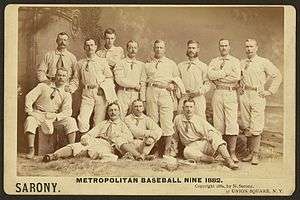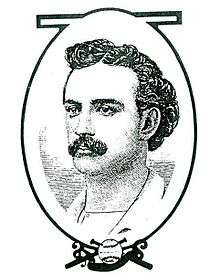New York Metropolitans
| New York Metropolitans | |
|---|---|
| League | American Association |
| Location | New York City |
| Ballpark | St. George Cricket Grounds |
| Year founded | 1880 |
| Nickname(s) | The Mets |
| Former league(s) | St. George Cricket Grounds |
| Former ballparks |
|
| Colors | Teal Black White |
| 1883–1887 | 270-309 W-L |
| American Association Pennant (1) | |
| Ownership |
|
| Manager |
|

The Metropolitan Club (the New York Metropolitans or the Mets) was a 19th-century professional baseball team that played in New York City from 1880 to 1887. The New York Metropolitan Baseball Club was the name originally chosen in 1961 for the current day New York Mets franchise.[1]
History
Founding
The Metropolitan Club was founded in 1880 as an independent professional team by business entrepreneur John B. Day and baseball manager Jim Mutrie. Initially the team played its games in Brooklyn and in Hoboken, New Jersey as the other New York area clubs did at the time. However, by September, Day had arranged the use of a polo field just north of Central Park in Manhattan, bounded by 5th & 6th Avenues and 110th & 112th Streets. The site became known as the Polo Grounds, the first professional baseball park in Manhattan. The club name, "Metropolitan", had previously been used by a team that played its home games in the Hamilton Square neighborhood of New York as early as 1858.[2]
Joining the American Association
The National League had expelled the Mutual Club of New York following the 1876 season for failing to make their final road trip of the year and by 1881 had still not replaced them with another New York City franchise. The upstart American Association therefore saw a significant opportunity when it invited the Metropolitan to join the new league for its 1882 inaugural season. Metropolitan declined, however, since joining would have meant forgoing lucrative home exhibition games against National League opponents.
Because of Metropolitan's financial success at the Polo Grounds, and because each league knew that it needed a successful New York City franchise to compete against the other, at the end of 1882 both leagues tendered franchise offers to the Mets. Unbeknownst to the leagues, though, the Mets accepted both invitations. To satisfy these commitments, owners Day and Mutrie acquired the Troy franchise that had been eliminated from the National League (along with Worcester) to make room for new franchises in New York City and Philadelphia. Day and Mutrie entered the Mets into the American Association and a newly created New York club into the National League. The teams shared use of the Polo Grounds, which was reconfigured with two diamonds and two grandstands.
The club's name "Metropolitan" was used in published standings of the Association, while the name "New York" was used for the National League entry. In the style of the day, the clubs were often called the "Metropolitans" and the "New Yorks". The "New Yorks" would eventually acquire the separate nicknames of the "Gothams" and then the "Giants". The Metropolitan club was referred to alternately as the "Metropolitan," "Metropolitans" or the "Mets". They were also referred to, on occasion, as the "Indians".[3]
American Association successes
Initially, managed by Mutrie, the Metropolitans enjoyed greater success on the field than the Gothams. The Mets finished fourth in 1883, and won the 1884 American Association pennant. The Mets then faced Providence Grays of the National League in the 1884 World Series, but lost 3 games to none. Prominent Metropolitan players included Tim Keefe, Dave Orr, Chief Roseman, Jack Lynch, Candy Nelson and Dude Esterbrook.
Demise
Financially, though, the Gothams had more promise due to the National League's stability, quality of play, and higher ticket prices. As early as 1884, the Mets were struggling to establish their own identity, and opened the season in a new ballpark, Metropolitan Park, located on the east side of Manhattan. The move proved unsatisfactory, and by mid-season they had quietly moved back to their original Polo Grounds home.
Prior to the 1885 season, Mutrie shifted over to manage the Gothams and brought along star pitcher Keefe and third baseman Esterbrook. The rechristened New York Giants finished second in the National League in 1885, while the Mets slumped to seventh place in the AA.
Prior to the 1886 season, Day and Mutrie sold the Mets to Erastus Wiman who moved the team to cricket grounds on Staten Island in hopes of promoting ferry trade across New York harbor. This business plan did not succeed, though, and the Mets ceased operation following the 1887 season. The team was bought by the Brooklyn Dodgers to gain territorial protection and the contracts of several of the Mets' stars, including Dave Orr and Darby O'Brien. The current minor league Staten Island Yankees play in a stadium very near the cricket ground used by the Mets.
Present-day Mets
In 1962, when the National League added a franchise to replace the departed Giants and Dodgers, the owners and the fans of New York selected "Mets" as the nickname for the new club, in part to suggest continuity with the Metropolitans; its original formal name was the "New York Metropolitan Baseball Club." These 20th-century New York Mets played their first two seasons at the final version of the Polo Grounds before it was ultimately torn down in 1964, when the Mets moved to Shea Stadium. Noted New York radio personality Steve Somers of WFAN refers to the present-day Mets as the "Metropolitans."
Notable alumni
- Lip Pike, four-time major league home run champion
See also
- New York Metropolitans all-time roster
- 1883 New York Metropolitans season
- 1884 New York Metropolitans season
- 1885 New York Metropolitans season
- 1886 New York Metropolitans season
- 1887 New York Metropolitans season
- New York Mets (1962–present)
References
- ↑ "Mets Timeline | Mets.com: History". MLB.com. Retrieved 2013-01-27.
- ↑ "Baseball". New-York Daily Tribune. New York: Greeley & McElrath: 7. 16 August 1858. ISSN 2158-2661. OCLC 9388331. Retrieved 20 May 2015.
- ↑ "The Indians win an easy victory from Brooklyn". The Sun. New York. 83: 7. 24 October 1887. ISSN 1940-7831. OCLC 9406339. Retrieved 20 May 2015.
Additional reading
- O'Malley, John (1980). "The Mets open in New York". Baseball Research Journal 1980, 140–144.
- O'Malley, John (1985). "Mutrie's Mets of 1884". The National Pastime 4 (1), 39–41.
External links
- Metropolitans Team Index from Baseball-Reference.com
- The New York Metropolitans Hall of Records
- New York Public Library Metropolitans Page
- Staten Island Museum Metropolitans Page
